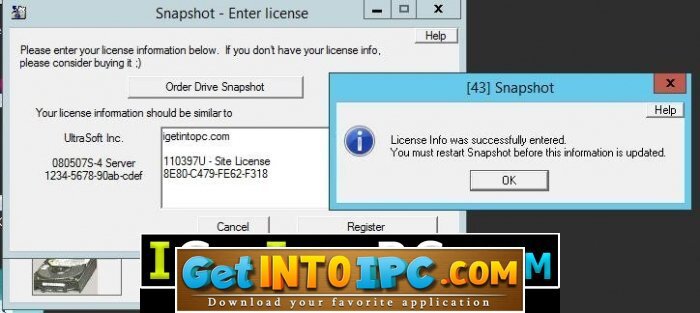

- #DRIVE SNAPSHOT RESTORE HOW TO#
- #DRIVE SNAPSHOT RESTORE INSTALL#
- #DRIVE SNAPSHOT RESTORE UPDATE#
 Read/write snapshots work like read-only snapshots, with the additional feature that if data is written to the snapshot, that block is marked in the exception table as used, and never gets copied from the original volume. In LVM2, snapshots are read/write by default. If a block is to be changed on the origin, it is first copied to the snapshot, marked as copied in the exception table, and then the new data is written to the original volume. Read-only snapshots work by creating an exception table, which is used to keep track of which blocks have been changed. What is the difference between LVM1 and LVM2 Snapshot? LVM1 Snapshots
Read/write snapshots work like read-only snapshots, with the additional feature that if data is written to the snapshot, that block is marked in the exception table as used, and never gets copied from the original volume. In LVM2, snapshots are read/write by default. If a block is to be changed on the origin, it is first copied to the snapshot, marked as copied in the exception table, and then the new data is written to the original volume. Read-only snapshots work by creating an exception table, which is used to keep track of which blocks have been changed. What is the difference between LVM1 and LVM2 Snapshot? LVM1 Snapshots #DRIVE SNAPSHOT RESTORE HOW TO#
Even when data modification is completed, the old data is never overwritten.ĪLSO READ: How to create filesystem on a Linux partition or logical volume.Instead of writing modified data over current data, the modified data is put in a new filesystem location.For modifying data, a clone or writable-snapshot is used. COW offers both safety and performance via snapshots.LVM Snapshot uses COW (Copy-on-Write) technology for Linux LVM snapshot backup and restore.Since boot is always a standard partition and not part of logical volume, you will not be able to take a snapshot of boot partition.The only challenge you may face is taking LVM snapshot of boot partition.But Linux LVM Snapshot backup and restore is a very ideal solution for handling timely security updates and patches on RHEL and CentOS environment.
#DRIVE SNAPSHOT RESTORE INSTALL#
In such case it is recommended that you take a backup of your data, scratch install new RHEL/CentOS major release and restore your data.Ideally experts recommend to avoid performing RHEL/CentOS upgrades for major version such as RHEL/CentOS 7 to RHEL/CentOS 8.
#DRIVE SNAPSHOT RESTORE UPDATE#
Linux LVM Snapshot backup and restore for RHEL/CentOS Update and Upgrade
Create, Extend, Merge and Remove LVM Snapshots. Comparison between LVM1 and LVM2 Snapshots. In this article I will give you and overview on Linux LVM snapshot backup and restore and cover below topics relatd to LVM Snapshots: Step 8: Restore boot partition (Optional). Step 7: Perform LVM restore snapshot for root file system. What is capital “O” in the Attr section of lvs command?. Step 6: Perform LVM Restore Snapshot for data partition. How to automatically extend Linux LVM snapshot size?. Recommendations to prevent Linux LVM snapshot corruption. Perform system updates, upgrades or patching. Step 5: Using source logical volume with snapshots. Step 3: Backup boot partition (Optional). Step 2: Check LVM Snapshot Metadata and Allocation size. How LVM Snapshot is different compared to backup solution?. What is the difference between LVM1 and LVM2 Snapshot?. Linux LVM Snapshot backup and restore for RHEL/CentOS Update and Upgrade.






 0 kommentar(er)
0 kommentar(er)
